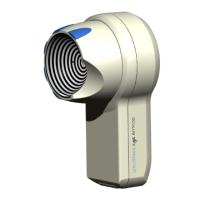Instruction Manual Easygraph
Page 67
2. The Periphery
The periphery of contact lenses must also be
entered after the base parameters have been
defined. Two peripheral zones, each with 3
parameters, can be entered:
• b1: Width of Zone 1:
• r1: Curvature of Zone 1
• dr1: Differences in curvature of the main
meridians (for toric lenses)
• b2: Width of Zone 2
• r2: Curvature of Zone 2
• dr2: Differences in curvature of the main
meridians (for toric lenses)
These parameters are used to define bevelled
lenses and those with more than one curvature.
If the curvature of a zone remains constant
throughout the entire series, it can be entered after
clicking the "r1 = constant" or "r2 = constant"
buttons.
If the curvature of the zones is not constant but
depends on the central radius, it can be defined by
using the formula: r1=r0*A+B. The parameters A
and B can be entered after this formula has been
clicked.
For example, the user can define the curvature of a
marginal zone as being invariably 0.8 mm greater
than the central radius (A=1 / B=0.8), or invariably
1.5 times the central radius (A=1.5 / B=0).
If toric lenses are to be defined, the "dr1=dr0*r1/r0"
/ "dr2=dr0*r2/r0" button should be clicked. This
copies the relationships of the central radii to the
periphery.
The value b2 must be specified as zero if the second
zone is not used; however, the remaining
parameters must have the same settings as those of
Zone 1. The value b1 may not be set to zero.
• Example: Bevelled lens with symmetrical axes of rotation (0.8 mm greater than the centralradii)
b1 = constant b1=0.25
r1=r0*A+B A=1.00 B=0.80
dr1 = constant
dr1=0
b2 = constant b2=0.00
r2=r0*A+B A=1.00 B=0.80
dr2 = constant
dr2=0
• Example: Bevelled lens with symmetrical axes of rotation (1.5 times central radius)
b1 = constant b1=0.25
r1=r0*A+B A=1.50 B=0.00
dr1 = constant
dr1=0
b2 = constant b2=0.00
r2=r0*A+B A=1.50 B=0.00
dr2 = constant
dr2=0

